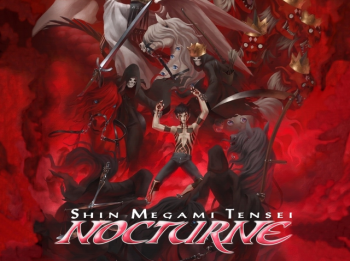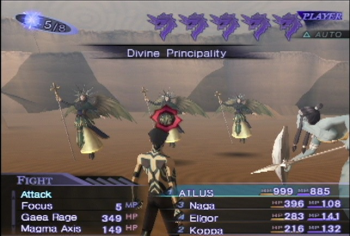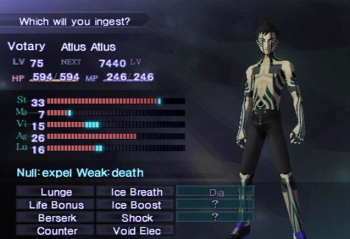Shin Megami Tensei and a Different Take on JRPGs (Part 1)
This may surprise some of you after my love letter to Etrian Odyssey, but for the longest time I didn’t like the RPG genre. During the mid 90s to early 00s, I was stuck between the grind-heavy traditional Japanese RPG (JRPG) design, and the number-crunching computer RPGs of the day. There were exceptions of course, such as Earthbound and Knights of the Old Republic. But it wasn’t until I found the Shin Megami Tensei series that I fell back in love with the genre.
 Change is Coming
Change is Coming
Shin Megami Tensei has been a Atlus staple since the early 90s; the brand has gotten so big that I have to split this examination into two parts, with this one covering the main branch titles.
The Shin Megami Tensei series has several staples that exist between all the games, with “change” being the principle theme. In every title, the protagonist is either a part of a cataclysmic event, or will be the one that changes the world forever by causing one. Aiding him are a changing stock of demons that the player can recruit through different means; usually by talking to them.
Demons belong to different families and have varying stats and powers. What’s important about the series’ design is that your party is never the same for long due to two things. First is that exploiting enemy weaknesses is vital to having any chance of beating a SMT game. (Later titles, such as Nocturne and Shin Megami Tensei 4, actively punished or rewarded the player for keeping track of element resists, but more on that in a minute.)
The second reason your party is never the same is due to how the demons are spread out throughout the course of a game. Every demon features a set of skills they earn while leveling up, with the demon usually getting everything after a few levels. Afterwards, the only improvements they see are minor stat increases. Later demons explicitly were built with higher stats and skills, so that the player must switch around their party often.
Once a demon is no longer relevant to your party, they can be used in the series’ fusion system: Combining two demons together to create a new one. How it works goes back to the families of demons. Each combination will in turn produce a demon of a different family, as long as the donor demons belong to two different families. Each game features slight variations on summoning, but normally the created demon will be dependent on the average of the two demon’s experience level.
Another factor to consider is that the created demon will have access to that demon’s normal pool of skills, along with skills from the two donor demons. This is the setup for Shin Megami Tensei‘s advanced play: Combining demons to produce powerhouses to get through the game’s challenges. Two popular examples are preserving a very useful healing or buff skill, by continually fusing it to your most powerful demons to keep it accessible. Another one is fusing skills that provide element resistances to a demon who would normally be weak against it; by doing this, you can remove or mitigate the demon’s weakness.
If you haven’t guessed by now, the Shin Megami Tensei series is very similar to Pokémon, in the use of an ever changing party roster. However Shin Megami Tensei did come first and is more mature, both in terms of design and storytelling.
The Moral of the Story
Another important element that ties all the games in the Shin Megami Tensei brand together is the role that morality plays in how the story progresses. In each game, the player will meet characters and demons that belong to one of three alignments: Chaos, Neutral and Order. How the player responds to choices and what demons they use will tilt their alignment towards one of the three. In response, certain characters may not interact with the player and the game will move towards one of several different endings.
 From a storytelling standpoint, the alignment system and how it is represented in game is interesting, because the developers had to be careful with how they showed the belief systems.
From a storytelling standpoint, the alignment system and how it is represented in game is interesting, because the developers had to be careful with how they showed the belief systems.
It’s important to note that Chaos and Order are not defined as good or evil within the context of the series. Chaos represents freedom and power: Being able to do what you want, when you want, as long as you are strong enough. Order represents structure and loyalty: Everything belongs in a certain place and has purpose, and you must believe in a higher power to guide you.
Neither one is shown as the “correct” way to live; no matter how you choose there will be consequences to your actions. This is usually represented by the main character’s friends, who start out slightly tilted to one of these beliefs. Over the course of the game, they will usually move further and further until they are extremists of their chosen path and the player must decide who to side with. Going neutral is an option, but given how your alignment shifts via choices, it can be difficult to get that ending.
Returning to the gameplay, Shin Megami Tensei features some of the hardest combat in a JRPG series.
Critical Combat
Combat in a Shin Megami Tensei game follows the traditional JRPG turn based design, but there are a few challenging twists. Combat revolves around striking at the enemy’s weakness, while making sure that you avoid getting hit by yours.
In the early games of the series, hitting a weakness simply gave you more damage, while hitting them with an attack they resist does less. Starting from Nocturne, that all changed with the introduction of the “Press Turn” system. Hitting an enemy with their weakness now extends the number of times you can attack during a single turn of combat. If the enemy resists the attack or absorbs it, you can lose some or even all your remaining actions for that turn.
 The Press Turn system made combat a lot more tactical compared to other JRPG series, and so did its use of aliments.
The Press Turn system made combat a lot more tactical compared to other JRPG series, and so did its use of aliments.
Traditionally, aliments like poison, blind and so on, were never really needed in combat, because it was just quicker to all out attack the enemy. But in the Shin Megami Tensei series, being able to strengthen your party or weaken the enemies was paramount to survival. Aliments lasted multiple turns and could have their affects stacked on an enemy.
Because of the Press Turn system, this also made combat a lot more dangerous compared to other series. If an enemy who strikes at your weakness gets a first strike, you could easily die without being able to do anything to stop it. In turn, normal encounters became very dangerous affairs and it was customary to save often. Earlier Shin Megami Tensei games would end if the main character was killed which, combined with instant death skills and the press turn system, sometimes made combat a game of Russian roulette.
But there is one final element that makes the Shin Megami Tensei games so challenging and different from traditional JRPGs: The bosses.
Fiendish Fights
The main branch of the Shin Megami Tensei games features some of the most challenging boss fights in any JRPG. Bosses always have multiple turns to attack, a variety of single and multi-targeting skills, and something special: A unique skill exclusive to them that makes fighting them a nightmare.
The boss fights require the player to master the series’ focus on a constantly changing party and the press turn combat to succeed. Unlike traditional fights in RPGs, where stats decide who wins, having a party tailored to the boss is more important. The first time I fought the first real boss fight in Nocturne, not paying attention to the rules and combat meant that it took me hours of grinding and dumb luck to win. When I returned to the game and this time paid attention to the rules, I beat him in 15 minutes.
For advanced players, many of the bosses can be created using the fusion system after beating them; providing the player with a powerful ally and one that could remain viable longer than normal party members.
To Be Continued
The Shin Megami Tensei brand may not have the fanfare of series like Dragon’s Quest and Final Fantasy, but it has built up a respectable sized fan base that can’t wait for the latest game. But games in the main branch are released rarely, with a ten year gap between Nocturne and Shin Megami Tensei 4. Part of the reason is due to how the brand has been expanded with side story games; allowing the developers to experiment with new game mechanics and stories while being able to return to the main design at any time.
But breaking down the various side story games will have to wait for another time because there is a lot to talk about, including how one of the stories has arguably become as popular as the main branch.
Josh Bycer is a Game Industry Analyst with over seven years of experience writing about Game Design and the Industry. You can find his posts, podcasts and daily videos on his site Game-Wisdom and contribute to his ongoing Patreon Campaign to help him continue to create great content.
[…] Previously I talked about what made the main branch of the Shin Megami Tensei series so amazing when it comes to Japanese Role Playing Game (JRPG) design. While the series has been going strong for over two decades at this point, it doesn’t have anywhere near the same number of titles as Final Fantasy. The reason has to do with how the developers have expanded things with side stories. […]